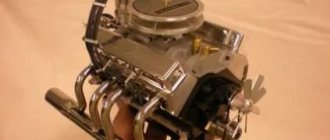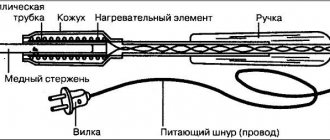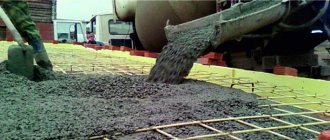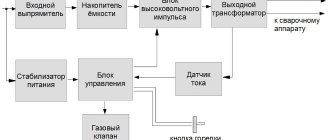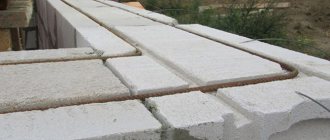A concrete pump is a unit that supplies freshly prepared mortar from the point where it is unloaded from a concrete mixer truck to the working area. Modern craftsmen cannot imagine carrying out repair and construction work without a concrete pump, which greatly simplifies and speeds up all stages where concrete and other mixtures are involved.
Most often, concrete pumps are used in the process of monolithic construction. Industrially produced units are quite expensive, but if you have the drawings and all the necessary materials, tools, as well as the necessary patience to strictly follow the instructions and standards, you can make a concrete pump yourself.
Externally, it will differ from the factory models, but the quality of work and the performance of all necessary functions will be identical. Subject to significant cost savings, a homemade concrete pump becomes the most preferable option for many.
What types of concrete pump designs exist?
Depending on the type of drive, concrete pumps can be hydraulic or mechanical. According to the design, pistonless and piston ones are poured. Depending on the method of movement, concrete pumps are either stationary or mobile. Despite the apparent diversity, today two types of concrete pumps are used in construction: piston (with hydraulic drive) and rotary (with mechanical drive).
In a rotary unit, the mixture is supplied by rollers equipped with the rotor housing: during the process of rotation, they press on the supply hose and the concrete is thrown out from there. But it is very difficult to make such a concrete pump yourself, since the design of the rotary type is complex, so usually piston units are assembled with your own hands.
The piston installation includes three main parts:
- Piston – powers the cylinder
- Cylinder - the part responsible for taking the mixture from the hopper and pumping it
- Drive – usually choose hydraulic or electromechanical
Single-piston units are most often used, since double-piston units require a complex design. Operation of two-piston units is carried out thanks to an electric or diesel engine, which converts hydraulic energy into mechanical energy.
Design and principle of operation of a concrete pump
There are two types of concrete pumps used in construction: piston and rotary. With homemade design, it is easier to make a piston pump. Structurally, this type of construction equipment consists of three main components:
The main components of the construction unit have auxiliary mechanisms and devices. The operating principle of a piston pump for concrete mixture is as follows:
Scheme of operation of a concrete pump.
There are two main types of concrete pumps: piston and rotary. Considering the complexity of the design of a rotary concrete pump, a piston version is chosen for manufacturing. In industrial and civil construction, equipment with two piston heads is used. This ensures uninterrupted operation of the unit and increases its performance. Making a homemade two-piston pump is a very difficult design task.
Return to contents
Principle of operation
Most of the main components of the concrete pump are equipped with auxiliary devices and mechanisms.
Unit action:
- The cylindrical base of the mechanism is equipped with two installation valves, through which the mixture is suctioned and pumped into the concrete pipeline.
- The piston head performs a reciprocating movement in the cylinder, thereby creating atmospheric vacuum. Thanks to this, the concrete is sucked in.
- When the piston head is in its extreme position, the working (reverse) stroke starts.
- The piston returns to its original position, creating excess pressure, due to which the mixture is drained into the concrete pipeline, and then begins to supply concrete mixture to the zone.
When making a manual concrete pump with your own hands, a piston mechanism is usually chosen. In civil and industrial construction, equipment with two piston heads is used, which guarantees uninterrupted operation of the device and significantly increases performance. They usually make single-piston concrete pumps with their own hands.
Piston
There are two types: rotary and piston. There is no need to examine the rotary device. Firstly, this does not make sense, since this will talk about how to make a piston concrete pump. And secondly, the rotary pump is complex in its design and disassembling its design will take a lot of time.
Diagram of a piston pump.
A piston concrete pump consists of three large parts, each of which performs its own function. These details are:
- piston;
- cylinder;
- drive unit.
Each of these parts consists of smaller components, which will be discussed below.
The cylinder is a container in which two check valves are built in. They are responsible for sucking the concrete mixture from the receiver and pumping it into the concrete pipeline. This process is possible thanks to the work of the piston.
Now the relationship between the operation of the piston and the cylinder will be examined in more detail. When the concrete pump starts, the piston begins to work (move). Making the first movement, the piston creates a discharge in the cylinder, which allows the concrete mixture to enter the receiver. The piston continues to move and, having reached the end point of its movement, begins to return to its original position. This process creates pressure that forces the mixture into the concrete pipe, which carries the concrete to the pouring site.
Diagram of a single-acting piston pump.
Industrial ones use two pistons for their work, which increases their power and complicates the technological parameters. This state of affairs is acceptable for large-scale construction projects, where the high cost of a two-piston powerful concrete pump will pay off in the process.
Buy or do it yourself?
Making a concrete pump with your own hands is not as difficult as it seems. The main thing is to calculate everything accurately in advance and use the drawings. Many people choose this option due to the fact that buying a factory model is expensive, and rent in terms of the number of hours and days is sometimes equal to the cost of parts and labor for constructing the device yourself.
You can buy a used concrete pump, but no one knows how long it will work and whether it will be able to efficiently perform its functions. It is much more profitable to make a mini-concrete pump with your own hands, being absolutely sure of the quality of the selected mechanisms and their operation, having assembled the unit in accordance with the requirements and required indicators.
Homemade installations are not as powerful as factory ones, but they are simple to implement and can ensure smooth, proper operation. Manufacturing a pump is advisable if small-scale repair and construction work using concrete mortar is regularly carried out or if a large house is being built. In this case, the costs will be fully recouped by the opportunity to speed up construction and save on labor.
Types of concrete pump designs
Among concrete pumps, two main types of design can be distinguished:
Screw pumps
Gerotor (screw pumps for concrete) equipment is capable of ensuring an even supply of concrete of any hardness. They are characterized by low engine noise.
Possible concrete blockages in the concrete pipeline are eliminated by reverse operation of the engine.
In general, it is recommended to use a gerotor pump for polystyrene concrete (other liquid and paste mortars) with a hydraulic piston system.
Such equipment has:
Please note that this is not the third or even the fifth floor, and concrete is also delivered here using a special pump
Piston pumps
A distinctive feature of modern piston equipment is:
The disadvantage is that it is more susceptible to wear and tear, which will affect your budget or the budget of the construction organization.
There are craftsmen for whom it is not a problem to design and assemble a concrete pump with their own hands. But this is far from a five-minute task and requires special skills and abilities. Although if you have such desire and strength, as well as detailed instructions, then everything is possible! And the incentive for your idea will be the final cost of a homemade concrete pump (within 60,000 rubles).
This diagram will help you understand the operation of the piston system of the equipment
How to make a simple concrete pump
To assemble a concrete pump with your own hands, you need to stock up on materials and tools that are indicated in the drawings. What you need: a steel pipe for the cylinder, a sheet of metal 5 millimeters thick, a lathe, round metal sheets (to make the piston and valve), a screwdriver, an electric motor, wrenches and bolts, a welded frame, a gearbox with a reduction gear, plastic or steel pipes for concrete pipeline.
Usually, for self-assembly, mechanisms with one piston are chosen.
The main stages of producing a mini-concrete pump with your own hands:
- Searching for a drawing, drawing up a plan indicating everything necessary, a design diagram.
- You need to select a cylinder and a piston - these are the key parts. The cylinder diameter should be a maximum of 400 millimeters (but smaller is better), the piston stroke should be at least 0.5 meters. If the parameters do not match, the mechanism will quickly wear out. Parts must be precisely made, without roughness.
- Pump selection - it can be hydraulic or electromechanical.
- Gearbox - must include a gear ratio to reduce and convert rotational movements into translational ones.
- King pin – connected to the mechanism.
- A metal corner is used as a welded frame.
- Making check valves from steel.
All parts are checked and assembled into a single mechanism using a drawing (it is desirable that there is also a drive diagram of all structural components). Next, you need to check your work. You cannot start the unit without concrete inside or a special starting mixture. It is prepared independently from an ordinary concrete mixture diluted in water, and then machine oil is added.
Making a concrete pump with your own hands: description of the device, production technology
Often, monolithic construction requires the help of small equipment. In this article we will talk about a pump for preparing a concrete mixture, without which it is impossible to imagine construction work. You can make this unit yourself without spending money on buying a unit in a store.
It is known that reinforced concrete mixtures began to be used more than a century ago; since then, construction with brick and wood has faded into the background.
The use of reinforced concrete greatly reduced construction time. Just a few decades ago, builders did not know how to properly mix the mortar, how to transport it to the work site and how to lift it to the upper floors.
Today there are answers to all these questions, since science does not stand still. An example of innovation is the appearance on the construction market of such a unit as a concrete pump .
By using this means of small-scale mechanization, flock houses can be built faster and with better quality.
In scientific terms, a concrete pump is a special equipment that receives concrete mixture and delivers it horizontally/vertically to the work site. In other words, this is a kind of piston machine for transporting freshly prepared concrete mixture.
How does a concrete pump work - how it works
In order to make a concrete pump with your own hands, you need to understand the operating principle of the installation. The most striking example is the piston concrete pump, which consists of three main parts:
- drive mechanism;
- cylinder;
- piston
Two check valves are installed in the body of the cylinder, through which the concrete mixture is drawn in and pumped into the pipes.
The piston, when moving along the cylinder, creates a vacuum, due to which the concrete begins to move.
After the piston reaches its end point, it creates pressure, and on the return stroke the concrete mixture enters the transport pipes, which lead to the place where the solution is laid or poured.
Double-piston pumps are most often found in stores ; they ensure shock-free operation of the installation and smooth operation.
DIY piston concrete pump
In order to make such a mechanism with your own hands, first of all you need to think through a plan for the manufacturing technology and draw up an installation drawing. The easiest way is to find a ready-made diagram of the unit and transfer it to whatman paper.
Next, you can move on to the process of manufacturing the main parts - cylinder and piston . To prevent pump components from wearing out, you need to select their size correctly.
The diameter of the working cylinder must be at least 4.2 cm. The piston should be selected according to the size of the working stroke; the optimal value would be a stroke of 50–90 cm.
Check valves must be made of alloy steel; this material can withstand prolonged exposure to concrete mixture.
Round parts are made on a lathe. They are brought to the required dimensions and cleaned using emery and grinding wheels. The valves are assembled with a screwdriver, and the structure is assembled using wrenches. After this, the finished concrete pump is connected to the drive.
It is necessary to separate hydraulic and electromechanical types of drives . The latter is used most often. It is started by a three-phase motor. It is supplied to the piston rod through a converter mechanism and a reduction gearbox.
Thanks to the mechanism, the circular movements of the shaft are converted into translational movements of the piston rod. That is, it works back and forth.
The drive is mounted as follows:
- an electric motor with a starting mechanism is attached to the base;
- the gearbox is bolted to its shaft;
- next, the conversion mechanism is assembled;
- the mechanism is connected to the reduction gear shaft and the piston;
- The power cable is connected to the electric motor.
Materials and tools
What materials and tools will be needed? To make a concrete pump with your own hands, you need to prepare in advance:
- Whatman paper, pencil, compass, ruler;
- five-millimeter sheet of iron;
- steel pipe for making a cylinder;
- steel for the piston and valves (preferably round);
- lathe;
- electric motor;
- wrenches, bolts, screwdriver;
- pipes for pumping concrete mixture (steel and plastic);
- reduction gear;
- water, cement;
- welded frame.
What types of concrete pumps are there?
There are several types of concrete pumps:
- on mobility (stationary and mobile);
- by type of mixture supply (piston and vacuum).
As mentioned above, the most popular are piston pumps . Vacuum ones are used less frequently; the concrete mixture is fed into them by creating a vacuum in the receiving tray.
Stationary concrete pumps cannot move independently; they are transported on a trailer. They also do not have arrows for feeding the mixture, which is not always convenient. Mobile installations are the most common; they most often use truck-mounted concrete pumps and units on vehicle chassis.
Pump assembly highlights:
- A lathe is used to create some items, usually small round parts that, once created, need to be cleaned and finished to the desired size.
- The body is made of sheet iron.
- When choosing a drive, you need to take into account the features of different designs: it must be economical and simple.
- Starting a concrete pump requires the presence of the following basic parts: a gearbox that reduces the gear ratio, an asynchronous electric motor with a 3-phase feed, and a reciprocating piston converter. There are special requirements for the quality of these parts, since the correctness and efficiency of the concrete pump will directly depend on them.
- Everything is assembled easily: a frame is welded from metal profiles, all elements are attached to it according to the diagram, and the electric motor is connected to the switch. The gearbox is bolted to the engine, the converter is mounted, and the cable is connected to the engine.
- After checking, the concrete pump must be disassembled and cleaned - the same as after each time the building mixture is prepared.
- If you need to make a mobile concrete pump with your own hands, you can install it on a single-axle trailer.
Application in construction
A concrete pump is needed to supply the mixture to the place of its use, and also to perform work in hard-to-reach places. The unit significantly speeds up the work process, therefore it is used wherever concrete is used: the construction of residential and industrial buildings, private and multi-storey buildings, bridges, tunnels, etc.
The output of a concrete pump can be 20-150 m3/hour. Operation of the device is simple: concrete is delivered from the container to the site, automatically pumped in the required mode. The equipment can be used all year round - for this there is a diesel fuel heating system, and thermal insulation can be provided.
Maintenance of concrete pumps is simple: after each preparation of the mixture, it is enough to use a flushing pump with a water gun. The unit can operate around the clock.
Advantages of automatic pumps for pumping concrete:
- A special electronic control unit ensures uninterrupted and correct operation of the concrete pump. It is possible to select the desired mode and carry out constant monitoring.
- An autonomous system for washing the concrete pump and concrete pipeline is built in, which reduces the time spent on servicing the unit.
- There is lighting for working in the dark (the concrete pump itself and the working area).
- A sound alarm has been installed - the warning system is working.
- The ability to regulate the concrete distribution unit has been implemented.
- A typical concrete pump kit includes: a concrete pipeline (up to 80 meters long), software, and a flushing system.
- It is possible to add a concrete distribution boom to facilitate delivery of the mixture to the site.
- The engines comply with all international standards (EURO-4 inclusive).
- In the creation of concrete pumps, components from the world's best manufacturers are used, guaranteeing high quality work, reduced repair and maintenance costs, and increased service life.
A concrete pump is a very important unit on a construction site, greatly facilitating and speeding up the execution of a lot of labor-intensive tasks. It can be purchased ready-made or assembled yourself from simple parts and mechanisms. Self-assembly of a mini-concrete pump will result in a simple and effective unit that will become an indispensable assistant in construction.
